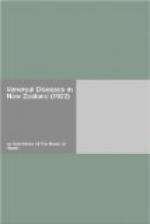When confronted with typical cases of difficulty already quoted some of the witnesses admitted that it was not easy to see how such cases could be dealt with satisfactorily without compulsion of some kind. But they argued that, even so, it would be a greater evil if the fear of publicity and the fear of compulsion should have the effect of deterring sufferers from seeking treatment and so drive the disease underground.
The National Council of Women, by a substantial majority, at a recent conference in Christchurch, carried a resolution protesting against a proposal to introduce compulsory notification and treatment of venereal diseases, and urging the Government to increase the facilities for free treatment. The President of the Council, however, informed the Committee that most of the nineteen societies affiliated to the Auckland Branch of the National Council are in favour of some form of compulsion, but a number of the southern branches are opposed to it. Speaking as an individual, and not as President of the National Council of Women, she added:
“Personally, I have no first-hand knowledge as to whether the disease is so prevalent in the community as to demand urgent measures, but there is an opinion among women social workers and medical practitioners, whom I have consulted, that something should be done, and they are in favour of compulsion under the Act, provided its administration is satisfactory. There is no doubt that there is a genuine and widespread fear among a large number of women that, although in the Act itself there is no discrimination between men and women, in actual practice there will be, and they fear that the Act will be enforced against women, and particularly immoral women, while the men concerned will be allowed to go free. This fear arises partly from the remembrance, particularly among elderly women, of the old Contagious Diseases Acts, both here and in England, and partly from the reports of the working of compulsion in Western Australia and elsewhere. I am of opinion that there is no serious ground for fear in view of the changed attitude in the public mind in connection with these diseases, the fuller knowledge that people generally have, and the high status of women in our country; also the ready access that all persons have to the protection of the law and the Courts in the event of false information being given, and the safeguards embodied in the Bill as I understand it is drafted. My view is that the objection to the compulsory clauses of the Bill would be removed in the opinion of many women if women patrols or women police were appointed, so that the administration of the Act in its compulsory clauses wherever it treated women could be in the hands of those women officers.”




